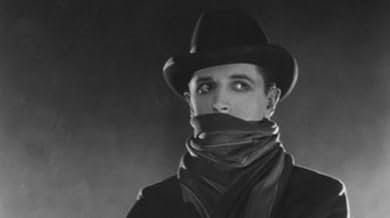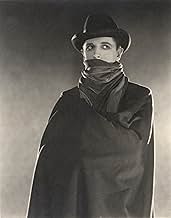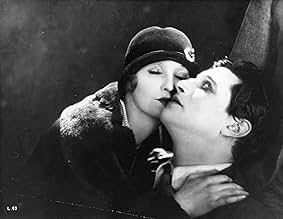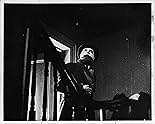AVALIAÇÃO DA IMDb
7,3/10
14 mil
SUA AVALIAÇÃO
Uma proprietária suspeita que seu novo inquilino é o louco que mata mulheres em Londres.Uma proprietária suspeita que seu novo inquilino é o louco que mata mulheres em Londres.Uma proprietária suspeita que seu novo inquilino é o louco que mata mulheres em Londres.
- Direção
- Roteiristas
- Artistas
June Tripp
- Daisy - A Mannequin
- (as June)
Wallace Bosco
- Pub Customer
- (não creditado)
Daisy Campbell
- Mother
- (não creditado)
Maudie Dunham
- First Victim
- (não creditado)
Reginald Gardiner
- Dancer at Ball
- (não creditado)
Eve Gray
- Showgirl Victim
- (não creditado)
Alfred Hitchcock
- Extra in Newspaper Office
- (não creditado)
Alma Reville
- Woman Listening to Wireless
- (não creditado)
Avaliações em destaque
A stranger (Ivor Novello) in fog-bound London seeks accommodation from a family and they provide him with a small apartment upstairs. Their blond daughter is drawn towards this fascinating and somewhat mysterious gentleman. Her parents become suspicious of the intentions of the lodger and they live in fear of her safety. There is a serial killer abroad in the foggy streets and who knows? this stranger could be that maniac.
It is interesting to view an early Hitchcock film as far back as the silent era. I am surprised at the quality (despite a few scratches here and there). The addition of music is rather overdone in my opinion but it does fill in the empty silence and does add a dramatic effect. No doubt in the early days a capable pianist (below the screen) bashed out some impromptu music to fit the mood of each scene.
It is an uncomplicated story but that does not mean the guilty person is easily recognized (if at all!) Hitchcock likes to tease with a lodger who has shifty eyes, who paces the floor (what an original idea to photograph through a transparent floor), who has the wall pictures removed and who creeps out silently at night.
I feel that the atmosphere created is exceptional. Certainly a bit theatrical with exaggerated eye expressions but compelling nevertheless.
When you see a film of this vintage you realise how much film production had already advanced in the 20's and without the aid of all our recent technological contrivances.
It is interesting to view an early Hitchcock film as far back as the silent era. I am surprised at the quality (despite a few scratches here and there). The addition of music is rather overdone in my opinion but it does fill in the empty silence and does add a dramatic effect. No doubt in the early days a capable pianist (below the screen) bashed out some impromptu music to fit the mood of each scene.
It is an uncomplicated story but that does not mean the guilty person is easily recognized (if at all!) Hitchcock likes to tease with a lodger who has shifty eyes, who paces the floor (what an original idea to photograph through a transparent floor), who has the wall pictures removed and who creeps out silently at night.
I feel that the atmosphere created is exceptional. Certainly a bit theatrical with exaggerated eye expressions but compelling nevertheless.
When you see a film of this vintage you realise how much film production had already advanced in the 20's and without the aid of all our recent technological contrivances.
The Lodger was the feature which Hitchcock himself described as his first true film (it was actually his third complete one), and film historians, particularly auteurists tend to focus upon it because it is it introduces themes of murder and suspense that Hitch's name would later be synonymous with.
To be honest, the first thing that strikes me upon watching The Lodger is its sense of rhythm. Hitchcock's earliest films were always very rhythmic and the opening moments of The Lodger are a great example, with a dynamic and attention grabbing sequence of shots and title cards. Much of this however may be down to the style of the seldom referenced screenwriter Eliot Stannard, who has a credit on all but one of Hitchcock's silents. Stannard was a master at telling stories in purely visual terms, and his screenplays often go as far as to map out series of interlocking images.
The next very obvious thing about The Lodger is that right from the start Hitchcock was more interested in cinematic technique than he was in performances or artistry. The Lodger is crammed with Expressionist effects, in particular double exposures. Hitch clearly hadn't learnt the art of subtlety yet and these are massively overused. We can also tell early on that Hitchcock was interested in using his camera to involve the audience in the film, throwing in point-of-view shots or drawing our attention to specific items. In this regard his technique was not yet refined. He was develop it in his later silents.
Of course what generally interests followers of Hitchcock's career is the fact that The Lodger is the first time he deals with the grisly subject of murder. It's true that there are many Hitchcockian elements here murder, blondes, a love triangle and even a MacGuffin in the form of the Avenger whom all the characters are concerned about but isn't the focus of the story. There is a kind of morbid sensationalism concerning the killings, something we'd see right through to the other end of Hitch's career with the comment about "ripped whores" in 1972's Frenzy. There's also of course a "wrong man", although here he appears more as the subject of a whodunit. The later Hitchcock would have focused upon the plight of the wrongly accused, and made a more suspenseful film in the process.
All in all, The Lodger isn't really as significant an early Hitchcock as some would believe. For one thing there is the influence of screenwriter Stannard and the fact that Hitchcock, although he may have relished the material, was still very young and inexperienced. The fact is The Lodger may contain more of Stannard's influence than it does Hitchcock's. It's not as if Hitchcock immediately began making more murder thrillers. The majority of his British thrillers are of the espionage/adventure variety, and it would take up until the early 40s for Hitchcock to really begin making masterpieces in the domestic murder genre. It's also nowhere near being Hitch's best silent film, even though it tends to be remembered over more polished works like The Ring and The Manxman. Taken out of context though, it is a fairly decent late silent thriller, with only a few minor flaws in plot and direction.
To be honest, the first thing that strikes me upon watching The Lodger is its sense of rhythm. Hitchcock's earliest films were always very rhythmic and the opening moments of The Lodger are a great example, with a dynamic and attention grabbing sequence of shots and title cards. Much of this however may be down to the style of the seldom referenced screenwriter Eliot Stannard, who has a credit on all but one of Hitchcock's silents. Stannard was a master at telling stories in purely visual terms, and his screenplays often go as far as to map out series of interlocking images.
The next very obvious thing about The Lodger is that right from the start Hitchcock was more interested in cinematic technique than he was in performances or artistry. The Lodger is crammed with Expressionist effects, in particular double exposures. Hitch clearly hadn't learnt the art of subtlety yet and these are massively overused. We can also tell early on that Hitchcock was interested in using his camera to involve the audience in the film, throwing in point-of-view shots or drawing our attention to specific items. In this regard his technique was not yet refined. He was develop it in his later silents.
Of course what generally interests followers of Hitchcock's career is the fact that The Lodger is the first time he deals with the grisly subject of murder. It's true that there are many Hitchcockian elements here murder, blondes, a love triangle and even a MacGuffin in the form of the Avenger whom all the characters are concerned about but isn't the focus of the story. There is a kind of morbid sensationalism concerning the killings, something we'd see right through to the other end of Hitch's career with the comment about "ripped whores" in 1972's Frenzy. There's also of course a "wrong man", although here he appears more as the subject of a whodunit. The later Hitchcock would have focused upon the plight of the wrongly accused, and made a more suspenseful film in the process.
All in all, The Lodger isn't really as significant an early Hitchcock as some would believe. For one thing there is the influence of screenwriter Stannard and the fact that Hitchcock, although he may have relished the material, was still very young and inexperienced. The fact is The Lodger may contain more of Stannard's influence than it does Hitchcock's. It's not as if Hitchcock immediately began making more murder thrillers. The majority of his British thrillers are of the espionage/adventure variety, and it would take up until the early 40s for Hitchcock to really begin making masterpieces in the domestic murder genre. It's also nowhere near being Hitch's best silent film, even though it tends to be remembered over more polished works like The Ring and The Manxman. Taken out of context though, it is a fairly decent late silent thriller, with only a few minor flaws in plot and direction.
Usually remembered as Alfred Hitchcock's first thriller, "The Lodger" is also a very good film in its own right. Although the acting is somewhat dated, and although there is not a really appropriate musical score that has survived, it has the carefully crafted plot and suspense that Hitchcock would become famous for.
The opening sequence uses the director's creative touches in setting the mood of a city terrorized by a mysterious killer, "The Avenger", who is targeting light-haired women. Then we meet the actual characters: an older couple and their daughter Daisy, and Daisy's policeman boyfriend. When a mysterious lodger appears and rents the family's extra room, his strange behavior begins to make them suspect that he might be the mad killer, even as he builds a close friendship with Daisy. As the story proceeds, tension and fear continue to build until an ending that is exciting, if somewhat melodramatic.
Hitchcock shows his mastery of silent film technique in using a wide variety of camera techniques and props to communicate the emotions of the characters. The acting is mostly good, although Ivor Novello as "the lodger" overplays his role rather noticeably. This is the kind of movie that could really benefit from a good musical soundtrack, and the fact that it is exciting to watch even without an appropriate score shows the quality of Hitchcock's craftsmanship.
Anyone who enjoys Hitchcock or silent films will definitely want to see "The Lodger".
The opening sequence uses the director's creative touches in setting the mood of a city terrorized by a mysterious killer, "The Avenger", who is targeting light-haired women. Then we meet the actual characters: an older couple and their daughter Daisy, and Daisy's policeman boyfriend. When a mysterious lodger appears and rents the family's extra room, his strange behavior begins to make them suspect that he might be the mad killer, even as he builds a close friendship with Daisy. As the story proceeds, tension and fear continue to build until an ending that is exciting, if somewhat melodramatic.
Hitchcock shows his mastery of silent film technique in using a wide variety of camera techniques and props to communicate the emotions of the characters. The acting is mostly good, although Ivor Novello as "the lodger" overplays his role rather noticeably. This is the kind of movie that could really benefit from a good musical soundtrack, and the fact that it is exciting to watch even without an appropriate score shows the quality of Hitchcock's craftsmanship.
Anyone who enjoys Hitchcock or silent films will definitely want to see "The Lodger".
In a quiet British town, a serial killer known as The Avenger is on the loose. Noted for his partiality for blondes, The Avenger has killed seven women-and shows no signs of stopping.
Ivor Novello, as the title character, is a quiet and mysterious man who appears at a boarding house soon after the seventh murder is committed. The landlady reluctantly allows him to stay in an upstairs room, but becomes suspicious when she notices the young man turning over all the portraits of blonde-haired women in his room. It doesn't help the landlady's suspicions when the man begins showing an interest in her daughter, Daisy (naturally, a blonde). Daisy's boyfriend, a detective, is assigned to The Avenger's case, and (almost immediately) becomes suspicious of the lodger as well.
Although The Lodger isn't Hitchcock's first feature, it most certainly is the film that launched his career as the "Master of Suspense." Noticeable Hitchcock trademarks are apparent here-namely the lodger's arrival and the ceiling/mirror scene.
Loosely based on the infamous serial killer Jack the Ripper, this silent thriller is fast-paced with exceptional performances. The score, at times, seems out of place, but Hitchcock fans will nonetheless enjoy this film.
Ivor Novello, as the title character, is a quiet and mysterious man who appears at a boarding house soon after the seventh murder is committed. The landlady reluctantly allows him to stay in an upstairs room, but becomes suspicious when she notices the young man turning over all the portraits of blonde-haired women in his room. It doesn't help the landlady's suspicions when the man begins showing an interest in her daughter, Daisy (naturally, a blonde). Daisy's boyfriend, a detective, is assigned to The Avenger's case, and (almost immediately) becomes suspicious of the lodger as well.
Although The Lodger isn't Hitchcock's first feature, it most certainly is the film that launched his career as the "Master of Suspense." Noticeable Hitchcock trademarks are apparent here-namely the lodger's arrival and the ceiling/mirror scene.
Loosely based on the infamous serial killer Jack the Ripper, this silent thriller is fast-paced with exceptional performances. The score, at times, seems out of place, but Hitchcock fans will nonetheless enjoy this film.
... a thriller based on the book by Marie Belloc Lowndes. A mysterious killer known as "the Avenger" is terrorizing the streets of London. He targets women with blonde, curly hair, and the police are at a loss to stop him. Meanwhile, a sketchy new lodger (Ivor Novello) takes up residence in the rooming house of a landlady (Marie Ault) and her husband (Arthur Chesney). The landlady becomes convinced that the lodger is really the Avenger, which proves problematic as the lodger has caught the attention of the landlady's daughter, Daisy (June Tripp). Also featuring Malcolm Keen as Daisy's policeman boyfriend.
Inspired by the Jack the Ripper case, this was Hitchcock's first suspense picture, and was an immediate success, with one critic at the time even calling this the "best British film ever made". This is my second time watching it, and the first time watching the beautiful BFI restoration. The quality of the print is outstanding, and the commissioned score is excellent. Hitchcock uses a number of visually impressive double exposure shots, and I also liked the stylized intertitles. I still find the movie a tad too long, and Novello, who looks striking, is a silent-era-style ham, but it's still worth checking out for silent film fans. Arthur Chesney, playing the landlord, was the lookalike younger brother of Edmund Gwenn, and the former husband of Estelle Winwood.
Inspired by the Jack the Ripper case, this was Hitchcock's first suspense picture, and was an immediate success, with one critic at the time even calling this the "best British film ever made". This is my second time watching it, and the first time watching the beautiful BFI restoration. The quality of the print is outstanding, and the commissioned score is excellent. Hitchcock uses a number of visually impressive double exposure shots, and I also liked the stylized intertitles. I still find the movie a tad too long, and Novello, who looks striking, is a silent-era-style ham, but it's still worth checking out for silent film fans. Arthur Chesney, playing the landlord, was the lookalike younger brother of Edmund Gwenn, and the former husband of Estelle Winwood.
Você sabia?
- CuriosidadesFor the opening of this movie, Sir Alfred Hitchcock wanted to show the Avenger's murder victim being dragged out of the Thames River at night with the Charing Cross Bridge in the background, but Scotland Yard refused his request to film at the bridge. Hitchcock repeated his request several times, until Scotland Yard notified him that they would "look the other way" if he could do the filming in one night. Hitchcock quickly sent his cameras and actors out to Charing Cross Bridge to film the scene, but when the rushes came back from the developers, the scene at the bridge was nowhere to be found. Hitchcock and his assistants searched through the prints, but could not find it. Finally, Hitchcock discovered that his cameraman had forgotten to put the lens on the camera before filming the night scene.
- Erros de gravaçãoWhen The Lodger (Ivor Novello) and Daisy (June Tripp) are playing chess, but the board is set up inappropriately. The square in the right corner should always be white. In this case, the bottom-right square is dark (black). This is the most obvious when The Lodger (Ivor Novello) is poking the coals in the fireplace.
- Citações
Joe Betts: Does this lodger of yours mean any harm to Daisy?
The Landlady: Don't be silly, Joe. He's not that sort. Even if he's a bit queer, he's a gentleman.
- Cenas durante ou pós-créditosClosing credits: Thank you to everyone who supported the BFI's Silent Hitchcock restoration project.
- Versões alternativasThe original version of The Lodger directed by Alfred Hitchcock in 1926 was restored in 1999 in honor of the directors 100th anniversary. The film was restored by the British National Film & TV Archives and a new score by Ashley Irwin was commissioned by ZDF/ARTE (Germany) and premiered on August 13, 1999 (what would have been Hitchcock's 100th birthday).
- ConexõesEdited into Histoire(s) du cinéma: Une vague nouvelle (1999)
Principais escolhas
Faça login para avaliar e ver a lista de recomendações personalizadas
Detalhes
- Data de lançamento
- País de origem
- Idioma
- Também conhecido como
- O Estrangulador de Louras
- Locações de filme
- Empresas de produção
- Consulte mais créditos da empresa na IMDbPro
Bilheteria
- Orçamento
- £ 12.000 (estimativa)
- Faturamento bruto mundial
- US$ 83.568
- Tempo de duração1 hora 32 minutos
- Cor
- Mixagem de som
- Proporção
- 1.33 : 1
Contribua para esta página
Sugerir uma alteração ou adicionar conteúdo ausente

Principal brecha
By what name was O Pensionista (1927) officially released in India in English?
Responda



























